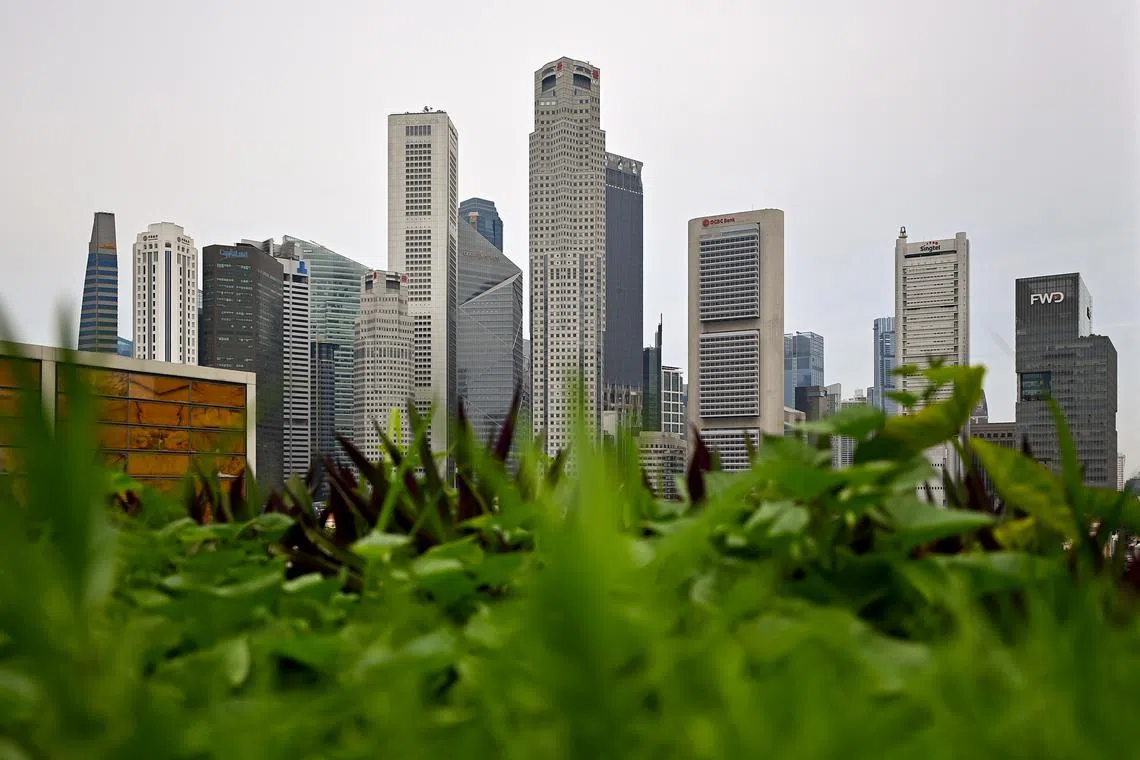Singapore sets eligibility criteria for carbon credits that can be used to offset carbon tax
Sign up now: Get ST's newsletters delivered to your inbox

The criteria help to ensure that the chosen carbon credits are of “high environmental integrity”.
PHOTO: ST FILE
Follow topic:
SINGAPORE - A set of eligibility criteria was released on Wednesday to ensure that the carbon credits used by companies to offset part of their taxable emissions are of high quality.
From 2024, the carbon tax will be increased
Companies can, however, use international carbon credits to offset up to 5 per cent of their taxable emissions.
To ensure the chosen carbon credits are of “high environmental integrity”, the Government has developed seven principles that each project has to abide by.
Announcing this in a recorded address at the Energy Efficiency National Partnership Awards at Marina Bay Sands on Wednesday, Minister for Sustainability and the Environment Grace Fu said the eligibility criteria were developed in consultation with over 70 stakeholders across the industry and non-governmental organisations.
The criteria take reference from international standards, including the Carbon Offsetting and Reduction Scheme for International Aviation, or Corsia – regarded as having the most rigorous standards in the industry.
“We are developing the market and rules in parallel, with the aim of publishing a list of eligible carbon credit programmes, methodologies and host countries later this year,” Ms Fu added.
For international carbon credits to be eligible for use by companies to offset their carbon tax obligations, they must be generated under implementation agreements that Singapore has signed with the projects’ host countries.
So far, Singapore has substantively concluded negotiations with Ghana and Vietnam on implementation agreements that are compliant with Article 6 of the United Nations’ Paris Agreement.
Similar agreements with over a dozen countries, including Papua New Guinea, Bhutan, Mongolia and Peru, are in the works, said Ms Fu.
To be considered eligible, the certified emission reductions or removals from the carbon credit project must have occurred between Jan 1, 2021 and Dec 31, 2030, said the Ministry of Sustainability and the Environment and the National Environment Agency (NEA) in a statement on Wednesday.
For example, providing households with biogas digesters, which convert organic waste into clean energy for heating and cooking, would help reduce their reliance on firewood and the resultant carbon emissions from deforestation.
Each tonne of carbon dioxide, or CO2, that has been prevented from being released into the atmosphere is equivalent to one carbon credit.
Likewise, forest or peatland restoration efforts can help to remove CO2 from the atmosphere, and each tonne of CO2 removed can be accounted for as a carbon credit.
For forest conservation projects to be considered, the project developers would need to reference baseline deforestation rates set across entire jurisdictions, to ensure the project’s supposed benefits are not over-stated – as stipulated by Corsia.
However, many projects, particularly those in Asia, currently allow developers to determine their own reference areas to measure deforestation rates.
The Government is still assessing whether high forest, low deforestation (HFLD) credits qualify under Singapore’s criteria, despite these being Corsia-approved.
This new class of credits “rewards” countries that have preserved forests and kept deforestation rates low, though some have countered that this does not represent additional emission savings.
“As environmental integrity standards continue to evolve, the eligibility criteria will be reviewed periodically to align with developments in Article 6 and high-integrity carbon markets,” said the ministry.
For carbon credit projects that are later found to be controversial, the authorities will make a case-by-case assessment on whether to “disqualify” them from use, by considering actions taken by the carbon credit programmes to address these alleged shortcomings and the safeguards that they have in place.
An international advisory panel for carbon credits has been set up to advise the Government on Singapore’s policies relating to carbon credits. It is chaired by Nanyang Technological University’s president emeritus Bertil Andersson.
The panel has five other members with expertise in sustainability, international development and finance – former Canadian climate minister Catherine McKenna; carbon markets expert Professor Koh Lian Pin; former head of the UN’s climate change office Patricia Espinosa; former executive in the UN’s development programme Usha Rao-Monari; and Ms Yuki Yasui, Asia-Pacific director of the Glasgow Financial Alliance for Net Zero.
NEA is also developing a national registry to account for and track the carbon credits that have been surrendered by the taxable facilities.
It has signed agreements with five carbon credit programmes to leverage their capabilities in ensuring the carbon credits issued under their programmes and subsequently used by companies to offset their taxable emissions are “robustly validated, verified, issued and retired”. They comprise Gold Standard, Verra’s Verified Carbon Standard, Global Carbon Council, American Carbon Registry and the Architecture for REDD+ Transactions, with NEA intending to expand its partnerships to more programmes in the future.
Asked whether companies will be incentivised to buy the credits to offset the carbon tax, Temasek-owned investment platform GenZero’s chief executive Frederick Teo said this will be likely if the cost is lower than paying the tax.
While there are no accurate price benchmarks for credits with corresponding adjustments to prevent double counting, some countries charge a premium for them. Ghana, for instance, imposes an additional fee of US$5 (S$6.85) per tonne.
Even then, there are still credits available at $25 per tonne or below, said Mr Teo. Such projects include those that provide stoves to reduce reliance on firewood, as well as nature restoration projects.
GenZero has an ongoing carbon credit project on land restoration in Ghana’s Kwahu region, which is on track to adhere to Singapore’s eligibility criteria.
Ms Lorna Ritchie, practice director for climate and sustainability at Global Counsel, noted that some companies may be willing to pay a premium over the carbon tax for offsets that have other co-benefits such as supporting sustainable development or biodiversity.
In this way, Singapore’s carbon price trajectory could help to improve price discovery in the international voluntary carbon markets by creating more demand for eligible, high-quality credits, she said.
“However, demand from Singapore is relatively small and unlikely to have a major influence on price movements in the international markets, as only about 50 entities in Singapore are required to pay the carbon tax, and they are only allowed to use carbon credits to offset 5 per cent of the tax payable,” Ms Ritchie added.
Air Carbon Exchange’s (ACX) head of APAC and global head of environmental products, Ms Hum Wei Mei, said companies or other countries may also use Singapore’s criteria as a benchmark for their own offsetting requirements – a positive step in setting regulations and scaling up carbon markets.
She added that ACX is planning to offer a standardised contract, which sells a portfolio of carbon credits that meet these criteria.
The seven principles that form the eligibility criteria for the use of international carbon credits are:
1. No double counting: If a company in Singapore buys carbon credits from a forest restoration project in Country X to offset part of its carbon tax liability, the emissions reductions can be counted towards Singapore’s climate targets only, not Country X’s climate targets.
2. Additionality: Implementation of the project and the financing from carbon credits bring the forest restoration efforts to fruition, when it would not have occurred under a business-as-usual scenario.
3. Real: The project must be proven to have removed the emissions from a realistic and conservative baseline, showing the amount of emissions that would have occurred in a business-as-usual scenario.
4. Quantified and verified: Calculation of the emission removals must be conservative and transparent, and measured and verified by an accredited and independent third-party verification entity before the carbon credit is issued.
5. Permanent: The emissions removed must not be reversible, with measures in place to monitor, mitigate and compensate for any reversal.
6. No net harm: The forest restoration project must not violate any laws, regulatory requirements or international obligations of the host country.
7. No leakage: The forest restoration project must not result in a material increase in emissions elsewhere, with measures in place to monitor, mitigate and compensate for such material increases.


